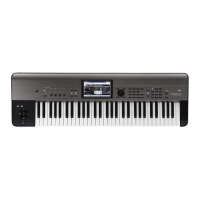COMBI P7: ARP/DT (Arpeggiator/Drum Track) 7–5: ARP Scan Zone
93
7–5: ARP
Scan Zone
These settings specify the note and velocity ranges that will
trigger arpeggiators A and B.
7–5a: Combination Name, Tempo
For more information, please see “Combination Select” on
page 70.
For more information, please see “ (Tempo)” on page 71.
7–5b: Zone Map
This shows the Scan Zone for each arpeggiator, A and B.
7–5c: Scan Zone A/B
A: , B:
Top Key [C–1...G9]
Bottom Key [C–1...G9]
Specifies the range of notes (keys) that will trigger
arpeggiator A/B. Top Key specifies the upper limit, and
Bottom Key specifies the lower limit.
Top Velocity [001...127]
Bottom Velocity [001...127]
Specifies the range of velocities that will trigger arpeggiator
A/B. Top Velocity specifies the upper limit, and Bottom
Vel oc it y specifies the lower limit.
Specifies the range of notes (keys) and velocities that will
trigger arpeggiator A/B.
Note: You can also set the note values and velocity values by
holding down an edit cell or the ENTER button and playing
a key (see OG p.10).
V
7–5: Menu Command
• 0: Write Combination see p. 101
• 1: Exclusive Solo see p. 101
• 2: Auto Setup Song see p. 101
• 3: Copy from Program see p. 101
• 4: Copy Arpeggiator see p. 103
For more information, please see “Combination: Menu
Command” on page 101.
7–7: Drum Track
Here, you can select a drum track pattern and specify how it
will sound.
Note: In Combination mode (unlike Program mode) there is
no dedicated timbre for the drum track. You can assign the
drum track program to be any timbre 1–16. The drum track
program will be played when the drum track’s MIDI
channel Output matches the timbre’s MIDI Channel.
In Combination mode, the drum track patterns are triggered
on the Global MIDI channel.
MIDI transmission and reception for the drum
track
In Combination mode, the Drum Track function transmits
and receives on the following MIDI channels.
Receive: If you’re controlling the triggering by playing the
keyboard, the drum track will receive on the global MIDI
channel.
Transmit: The drum track will transmit on the MIDI channel
specified by the Drum Pattern Output setting of each
combination.
Set this to match the MIDI channel of the timbre you’ve
specified for the drum program.
If the timbre’s Status is EXT or EX2, the note data etc. of the
Drum Track pattern will be transmitted.
If local control (“Local Control On Global P1:1‐1a) is on,
playing the KROME's keyboard will not make the internal
sound generator produce sound, nor can the keyboard
trigger the arpeggiator or drum track. However, they can be
triggered by note‐on messages from MIDI IN.
7–7a: Drum Pattern
Pattern [Preset, User]
[(Preset): P000...P605, (User): U000...U999]
This selects the drum pattern.
• U000–U999 can be written. Patterns you create in
Sequencer mode can be converted into user drum
patterns (see page 188).
Shift [–24...+00...+24]
This transposes the drum pattern in semitone steps. This
means that the instruments of the drum kit will change.
C–1 G9
Key zone of arpeggiator A
Velocity zone of
arpeggiator A
Velocity zone of
arpeggiator B
Key zone of arpeggiator B
Preset/User No. Contents
P000 Off
P000...P605 Preset drum patterns
U000...U999 For user/preloaded drum patterns

